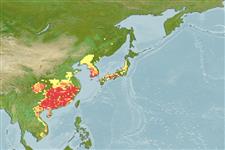Actinopterygii (ray-finned fishes) >
Cypriniformes (Carps) >
Cyprinidae (Minnows or carps) > Squaliobarbinae
Etymology: Mylopharyngodon: Greek, mylo = mill + Greek, pharynx = throat + Greek, odous = teeth (Ref. 45335).
Environment / Climate / Range
Ecology
Freshwater; demersal; pH range: 7.5 - 8.5; potamodromous (Ref. 51243); depth range 5 - 30 m (Ref. 6898). Subtropical; ? - 40°C (Ref. 55930), preferred ?; 53°N - 15°N, 100°E - 140°E (Ref. 55930)
Asia: Amur river basin to southern China (Ref. 55930). Reported from Vietnam (Ref. 44416). Persists only in Europe by stocking or accidental releases; native stocks in Russia have declined sharply (Ref. 59043). Several countries reported adverse ecological impact after introduction.
Length at first maturity / Size / Weight / Age
Maturity: Lm 91.5, range 100 - ? cm
Max length : 180 cm TL male/unsexed; (Ref. 40637); common length : 12.2 cm SL male/unsexed; (Ref. 35840); max. published weight: 35.0 kg (Ref. 56557); max. reported age: 13 years (Ref. 55930)
Dorsal
spines
(total): 0;
Dorsal
soft rays
(total): 7-9;
Anal
spines: 0;
Anal
soft rays: 8 - 10. Anatomy of the pharyngeal apparatus is the main distinguishing characteristic; throat teeth typically form a single row of 4-5 large molariform teeth on each of the two arches, with formula typically 1,4 - 4,1.
Adults inhabit large lowland rivers and lakes, preferably with clear water and high oxygen concentrations. Larvae feed on zooplankton, then on ostracods and aquatic insects. At about 120 mm SL, juveniles start to prey on small snails and clams while larger juveniles and adults feed almost entirely on molluscs. Undertake upriver migration and spawns in open waters. Deposit pelagic or semipelagic eggs which hatch while drifting downstream. Larvae settle into floodplain lakes and channels with little or no current (Ref. 59043). Maximum age probably exceeds 15 years; the figure of 20 years is not supported by data (Ref. 55930).
Prewspawning adults migrate upstream in spring - early summer; spawning takes place in turbulent waters; eggs are pelagic and drift downstream and larvae enter nursery areas such as flood plains or backwater habitats; main river channel is used as feeding and wintering area by subadults and adults.
Nico, L.G., J.D. Williams and H.L. Jelks, 2005. Black carp: biological synopsis and risk assessment of an introduced fish. American Fisheries Society, Bethesda, Maryland, USA. 337 p. (Ref. 55930)
IUCN Red List Status (Ref. 115185)
CITES (Ref. 94142)
Not Evaluated
Threat to humans
Potential pest (Ref. 74657)
Human uses
Fisheries: highly commercial; aquaculture: commercial
Tools
Special reports
Download XML
Internet sources
